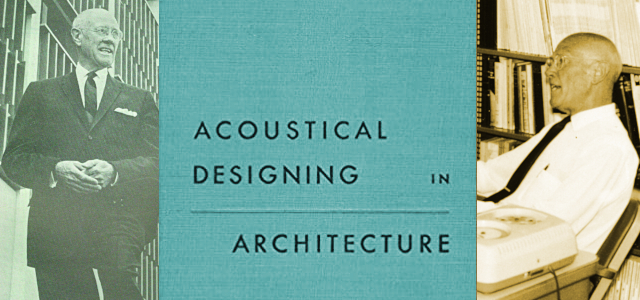Vernon “Vern” Knudsen was born in Provo UT on December 27, 1893, and served as a distinguished acoustician until his death on May 13, 1974. In many respects, his career bridged the architectural acoustical gap between Wallace C. Sabine and the commencement of the various acoustical consulting firms that began proliferating in the 1960s and 1970s. Known as Vern by his family, friends and associates, Knudsen is described as being a jovial individual who possessed a great sense of community ties.
Knudsen entered Brigham Young University (BYU) in 1911 with the intent of studying mathematics and electrical engineering. Perhaps to our benefit, he came under the influence of Dr. Harvey Fletcher. Fletcher convinced the young student that a career in physics, and notably acoustical sciences, might prove more meaningful.
Upon completion of his studies at BYU, the young Knudsen accepted a church assignment in the Chicago area. About the same time, World War I hostilities drew him into a naval research project investigating the propagation of telegraph signals in undersea cables. In the course of their investigations, Knudsen and his associates discovered that the Earth’s latent magnetism influenced the speed of telegraphic transmissions.
Western Electric Days
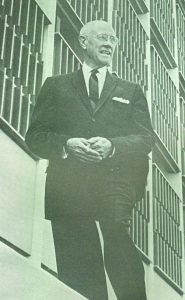
After the War, Knudsen rejoined his mentor, Harvey Fletcher, who by that time had succumbed to Western Electric’s (now Bell Labs) generous financial offers. Knudsen devoted his time and efforts to better understanding vacuum-tube technology. In concert with E.C. Wente, Maxwell and others, Knudsen forged ahead in the pursuit of the advancement of audio technology as it might apply to sound reinforcement and cinema audio reproduction.
One must remember that these developments spanned only five years, during which time major inroads into audio technology were made. In 1920, there was virtually no cinema sound reproduction; only crude representations of sound-reinforcement systems existed. Only seven years later, sound reproduction for the film industry was an acknowledged fact, and sound-reinforcement systems had become an established means to convey audio intelligence to large audiences.
In concert with E.C. Wente, Maxwell and others, Knudsen forged ahead in the pursuit of the advancement of audio technology as it might apply to sound reinforcement and cinema audio reproduction.
In 1919, Knudsen returned to the classroom, this time at the University of Chicago, where he pursued his doctorate under the tutelage of A.A. Michelson. Reflecting on his graduate studies, Knudsen wrote1: “While searching for a suitable subject for a doctoral dissertation, my conversion to acoustics was consummated. [Robert A] Millikan had proposed as the subject of my dissertation the contribution of electrons to the specific heat of metals. A problem that had been investigated but not solved by such distinguished scientists as Debye, Nernsi and even Einstein.”
Although the Millikan-proposed thesis was intriguing, Knudsen felt the exploration of such a subject would consume more time and resources than he was prepared to offer. As he noted, “Had I been rich and single, I probably would have yielded to Millikan’s persuasive proposal, but I was married and lacked affluence, and therefore felt that I should not take the risk of undertaking a ‘dead end’ problem [thereby] prolonging the doctoral process beyond three years.”2
During this crucial decision-making time, Millikan was slated to make an extended trip to Europe. With the support and encouragement of Professor Henry Gordon Gale, Knudsen embarked on a thesis involving his love of acoustics. His dissertation took the form of a study to show how small changes in intensity and pitch can influence hearing.
Otology—the study of diseases pertaining to the ear—was to be a familiar subject of Knudsen’s research over his lifetime.
During Millikan’s absence, Gale urged that Knudsen work diligently on his intended subject so that, “When Millikan returns, [he] would not have the heart to disapprove it.”3 Knudsen took the advice to heart and, in his words, “worked furiously” for the next three months on the completion of his thesis. Millikan, upon his return to Chicago, was somewhat startled by the impudence of his student, but soon acquiesced. He gave his blessing to the pursuit and introduced Knudsen to otologist George E. Schambaugh.
Over the next several years, as a result of this association, Knudsen and Schambaugh published a number of jointly authored papers on the subject of impaired hearing. This lead inevitably to an acquaintance with Dr. Norman A. Watson, which involved frequent conversations and correspondence regarding the subject of “normal vs. impaired hearing.” Otology—the study of diseases pertaining to the ear—was to be a familiar subject of Knudsen’s research over his lifetime.
The UCLA Era
To the surprise of his friends and associates, Knudsen spurned offers from the University of Chicago and Bell Labs, and instead accepted a position as an instructor at UCLA (University of California at Los Angeles). At the time, in 1922, UCLA was known as “the University of California-Southern Branch” and occupied a meager amount of real estate in what might be now considered downtown central Los Angeles. What drew Knudsen to a below-the-stairwell cubicle that he shared with other associate professors and affiliates has escaped record; perhaps he simply found it a challenge.
Knudsen became the first dean of the UCLA Physics Department and served in that capacity from 1933 through 1958, became vice chancellor in 1956 and finally, in 1959, became chancellor.
And what a challenge it was. Knudsen’s longtime associate and professional colleague Leo Delsasso remarked, during the presentation of the ASA’s gold medal to Knudsen in 1967, “In 1922, UCLA was without almost everything we now consider essential for a modern Department of Physics. Andrew Knudsen, Vern’s father, made the trek across the plains a generation before to settle in the desert of Utah. Vern confronted the lack of research space and equipment with the same drive and spirit that his father had displayed. He found in the Los Angeles Area many auditoriums and classrooms—mostly acoustically bad. In these [examples], with organ pipes and stopwatch in hand, he began [his] research on architectural acoustics.”
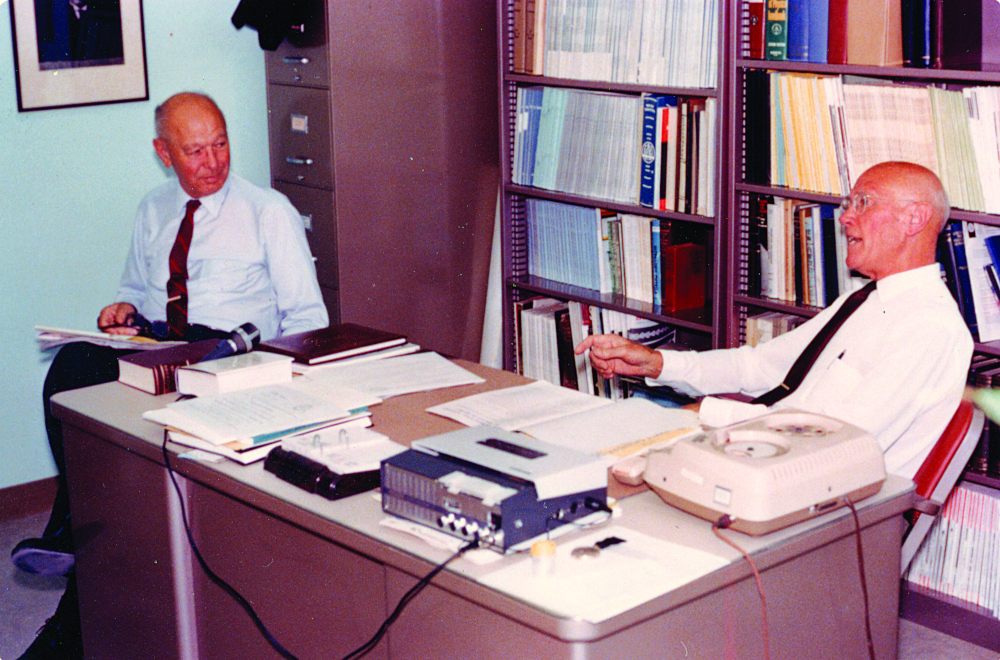
During Dr. Knudsen’s long tenure with UCLA, he consistently championed the further growth and funding for the institution’s physics program. When the university was relocated to its present Westwood location in 1929, Knudsen was influential in the construction of several reverberation chambers. These proved immensely effective in further studies of molecular relaxation phenomena in gases. These studies were to provide valuable information on the effect of humidity and atmospheric gases as they related to the transmission of audio information.
Prior to Knudsen’s studies, the relative effect of temperature and humidity on the transmission and reverberation of acoustical transmission had been given scant attention. Classic mentions regarding sound absorption in air as advanced by Kirchhoff, Stokes and Rayleigh took into account the effect of viscosity and heat conductivity, but neglected to address the effect of the presence of water vapor in the transmission medium. Knudsen reported, “When the humidity was well above 50%, the reverberation time of a high-pitched tone of 4000Hz was determined to be on the order of 4.0 to 4.5 seconds. Measurements made in the same room with a relative humidity of 14% displayed a reverberation time of 2.0 to 2.5 seconds.” Hence, he proved conclusively that temperature and humidity had a profound effect on the transfer of audio material.4
Knudsen served as ASA president from 1933 to 35, and was awarded the ASA’s Wallace C. Sabine medal in 1958 and the society’s Gold Medal in 1967.
Knudsen remained active in the academic world of UCLA for several decades. He became the first dean of the Physics Department and served in that capacity from 1933 through 1958. He became vice chancellor in 1956 and finally, in 1959, became chancellor of the institution. Knudsen always viewed progressing through the academic ranks with some skepticism. He commented: “To dean or not to dean, that is the question; the question each of us must answer when tempted to accept a deanship. If one is offered a deanship, one must almost always accept [such a position], but one makes the resolve, ‘I shall be a professor first and a dean second.’ Soon he becomes a dean first and a professor second. Ultimately, he becomes just a dean. Like the second law of thermodynamics, the process is irreversible. Deans may become Provosts or Vice Presidents or Presidents or Chancellors, but the process does not go the other way.”
He was to fly in the face of his earlier remarks when, in 1960, facing mandatory retirement, he left the UCLA academic hierarchy and resumed his beloved relationship with undergraduate students and the mystery of the research laboratory. He enjoyed this position until his death at age 80 from the ravages of Hodgkin’s disease.
Knudsen & The ASA
In the summer of 1928, Professor F.R. Watson of the University of Illinois, a prominent investigator in architectural acoustics, and Wallace Waterfall, who was then with acoustical material manufacturer Celotex, boarded a train heading for a meeting with Knudsen in California. Their trip, prompted by a desire to form an organization devoted to acoustical science, proved fruitful. As Knudsen commented, “It was decided to establish a society based largely on its relationship to Physics rather than to Engineering.”5
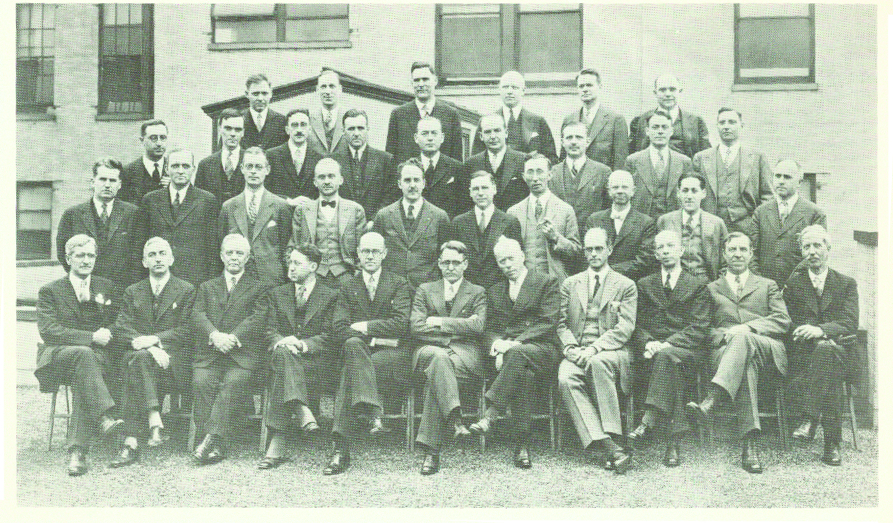
The prime candidate to lead the new organization was identified quickly as Dr. Harvey Fletcher. In an organizational meeting in December 1928, Dr. Fletcher agreed to serve as president of what eventually became the Acoustical Society of America (ASA). At the same time, Knudsen was named vice president.
Knudsen subsequently served as ASA president from 1933 to 35, and was awarded the ASA’s Wallace C. Sabine medal in 1958 and the society’s Gold Medal in 1967. The AES (Audio Engineering Society) also bestowed the John A. Potts Memorial Award to Knudsen in 1964.
Knudsen’s Contributions
Knudsen’s contributions to acoustical science were not solely academic in nature. He also pursued an active role in the design and testing of many architectural acoustic projects. Here’s a short list of some of these accomplishments:
- Sound Stages for MGM, Paramount Pictures, Fox, Universal and Warner Brothers, 1928/1933
- United Nations General Assembly, 1948
- Schoenberg Hall UCLA, 1955
- Dorothy Chandler Pavilion, Music Center, Los Angeles, 1964
- Grady Gammage Auditorium, Arizona State University (Tempe), 1964
- Honolulu Concert Hall, 1964
- Zellerback Hall, University of California Berkeley, 1969
- San Jose CA Community Theater, 1971
- Phoenix AZ Convention Center and Concert Theater, 1972
- Las Vegas NV Convention Center
- Anaheim CA Convention Center
- Fresno CA Convention Center
- Marin County (CA) Veterans Memorial Auditorium
During his long and distinguished career, he published about 110 papers devoted to acoustical matters6 and authored, in conjunction with Cyril M. Harris, the classic tome, Acoustical Designing in Architecture.7
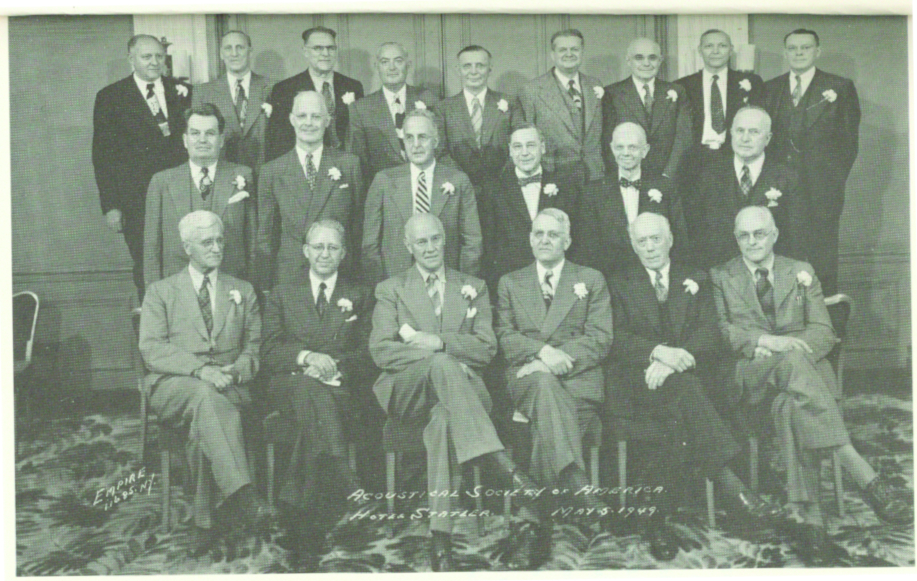
Perhaps Isadore Rudnick summed it all up when he delivered the following address on the occasion of Knudsen’s funeral: “He will always be remembered with affection and respect by those who knew him. If a man’s measure is the good he has done during his lifetime and the lasting mark he leaves on the lives of those whose paths he crossed, then Vern Knudsen was a giant among men.”
[Sincere appreciation is extended to Elaine Moran and the ASA staff for their assistance in preparing this manuscript.]
References
1 Journal of the Acoustical Society of America, Vol. 56, No. 2 Aug. 1974
2 Ibid.
3 Ibid.
4 Knudsen’s works on this subject were published in Vol. 5 of the Journal of the Acoustical Society of America, p112-126 entitled respectively, “The Absorption of Sound in Air, in Oxygen and in Nitrogen: Effects of Humidity and Temperature” by V.O. Knudsen, and “The Interpretation of the Anomalous Sound Absorption in Air and Oxygen in Terms of Molecular Collision” by Hans O. Kneser.
5 Knudsen, Reminiscences, Journal of the Audio Engineering Society, Vol. 18 No. 4, Aug. 1970
6 Editors I. Rudnick and T. Bomba, Collected Papers by Vern O. Knudsen from the Journal of the Acoustical Society of America, Sept. 1975
7 Knudsen and Harris, Acoustical Designing in Architecture, Acoustical Society of America ©1950, fifth printing 1988, ISBN 0-88318-267-X
This article was originally published in the January 2003 issue of Sound & Communications.
Click here for more of Sound & Communications’ “Industry Pioneers” series.
